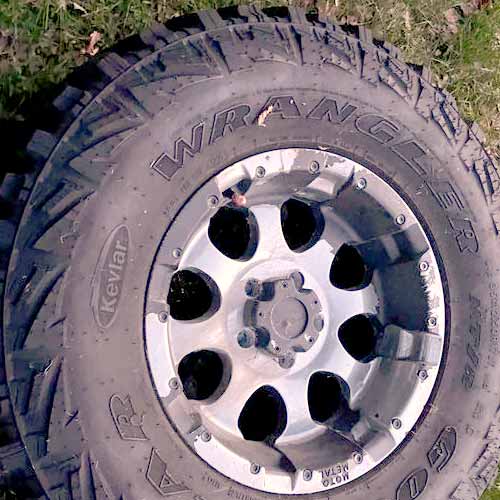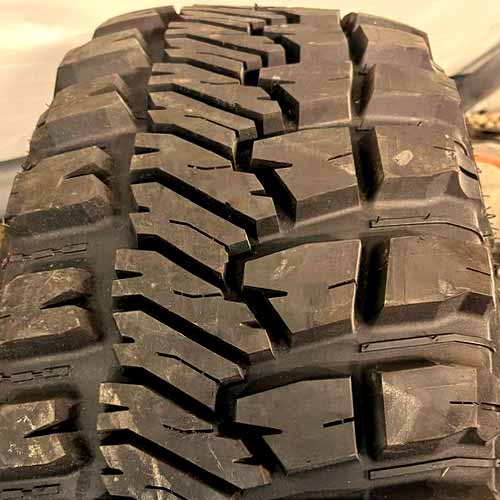Goodyear Wrangler MTR is an aggressive mud terrain tire which although is made with rugged terrains in mind, can also be used on pavements. But out of so many other mud tires, is it able to hold up? Lets find out!

Being a tire engineer, in my opinion, the Goodyear Wrangler MT/R Kevlar provides an epic crawling on not only mud, but all other challenging terrains. The tire is pretty tough to handle anything. On pavements although it offers decent dry gripping, the wet grip is limited, so is the comfort, but that’s the compromise you make whilst having superior off road traction. So overall, the tire serves its purpose well, you can say.
Tire Dimensions
The Goodyear Wrangler MTR comes in average sizes availability, going from 15 to 20 inches (rim diameter).
All it’s sizes have the speed rating of Q (which is usually the case with any MT).
And speaking of load range, all sizes have either C, D or E ratings.
So weight isn’t too much on this tire where the lightest size is just 47 lbs (LT 31X10.50R15) and the heaviest is 91 lbs (LT 42X14.50R17).
Lastly tread depth of the tire is seen to be either 18/32″, or 19/32″ or 21/32″.
Tread Design
The Goodyear Wrangler MT/R is two faced, meaning half of it’s tread provides a totally different shape than the other half.

The asymmetric design of this offers 3 unique lugs in the middle, where both the chunkier and elongated ones have notches in them along with rectilinear (full depth sipes).
Shoulder blocks on both sides also vary a lot where on one side you see with very minimal tread features (showing a squared off design).
Whereas the other side of the tire presents with shoulder blocks with full depth notches in them.
Both sides also have different types of stone ejector pattern as well.
If we look at the tire’s sidewall (see the image at the top of the page), the tire features N shaped lugs which are not too aggressive, especially when you compare tings with the middle.
These Kevlar reinforced sidewalls although, provide you with 35% better puncture resistance compared to simple MTR, the outer rubber lugs stay the same with similar design.
Highway Performance:
Mud tires are further divided in to two categories, there are some which are more aligned towards on road comfort, and then there are others, which are willing to sacrifice that for raw off road performance.
The GY MTR comes in the later. Let’s see why.
Steering:
The Goodyear MTR is a confusing tire, its asymmetrical tread is already where demanding in terms of handling, and here the very different sides of the tire act as a catalyst here.
So a very weird response is produced, the tire feels sharp turning on one side, while smooth on the other,
Dry Traction
On dry rubber to surface exposure is significant and here again the Goodyear MTR provides better gripping abilities from half of it’s tread while the other half isn’t as good as it’s lugs aren’t that closed up, and this limits the grip.
Same goes for the shoulder ribs, where one side there are full depth traction notches while the other side is smooth. The biter on one side makes overall a bumpier experience while the smooth tread blocks provide better effectiveness overall.
For Your Info: Toyo Open Country M/T provides one of the most capable grip on dry roads, detailed review:
https://tiredriver.com/toyo-mt-review/
Wet Traction Performance:
Generally Mud tires are not good on wet roads. And the Goodyear MTR is no exception here. Sure these tires are good at one component of overall performance, hydroplaning, but other than that, they lack severly in the gripping section.
These are they 2 main key components that judges the tires overall abilities here, so let’s discuss them both separately.
Wet Grip:
Wet grip of a tire as is highly dependent on the amount of siping, the Mud tires suffer in this department the most, but there are still a few mud tire that pull it off, and let me tell you…
The Goodyear Wrangler MTR is not one of them, as the tire severely lacks in wet traction overall.
That’s because the tire has no siping on it which is the key component here.
Sipes basically provide the tread with slits which soak up the water, and mud tires for off road purposes are given enough sipes.
But at least the tread composition of these tires are softer, which is also helpful, as it provides decent hydroplaning resistance.
Hydroplaning:
Resistance to hydroplaning is the tire’s ability to evacuate water from its tread so it would not float.
And Wrangler MTR being such a bald tire has no issues there, it’s interconnected grooves offer ample real estate for water to escape while it’s flexible tread molds in a way which makes negative pressure values, pushing water out faster.
Winter Traction Capability:
The Goodyear MTR is not branded with 3 peak mountain snow flake rating so the tire is not preffered for hard packed snow, where it’s a big fat NO for ice, with almost zero siping on the tread.
But you can still use these tire for deeper snow going up to 5 feet.
Tread Wear:
When it comes to mileage of a tire, it depends on a few key factors. Like there’s weight which determines the force with which the tire rolls on the surface, there’s compositions which also contributes to rolling resistance, as softer compound sticks more and then there’s tire’s structure which gives you biters.
The Goodyear Wrangler offers a ton of uneven biters with it’s asymmetrical design, so it’s very tough to maintain even wear on these tires.
The tire although keeps its weight at bay by featuring just a single cap ply of nylon, the 3 ply carcass still take things up to 90 lbs, which is a lot.
So the tire’s softer rubber gets to have larger rolling resistance values which generates faster wear, though the tire does get helped with good enough tread depth of up to 21/32″, which takes a little time to wear off.
Ride Quality:
The ride quality is determined by looking at the comfort levels of a tire, and here tire’s ability to dampen the tread noise and bumps is considered.
In case of bumps absorption, the Goodyear Wrangler MTR offers a soft inner construction of cap plies (where the tire on purpose only provides a single layer), the tire also offers very spongy outer tread rubber as well.
Both of these are efficient in soaking up the vibrations from the road.
But the tire is not comfortable in terms of noise, as it creates a lot of groove resonance which are not dampened by even pitch sequencing.
Pitch Sequencing basically is the method of reducing tread noise, where the geometry of every tread block is altered a little bit so that it can create a different tone, and sound waves can cancel out each other.
By the way, the quietest tire in the mud terrain category is Falken Wildpeak M/T (review).
Off Road Performance
Off road these tire are great and why won’t they be, until this point they compromised in nearly every section.
With powerful inner construction of 3 ply polyester with high turn up casing the Wrangler MTR can handle pretty much anything.
Where mud is a piece of cake for this tire, let’s discuss that including other terrains.
Rock Traction
On rocks, the Wrangler MTR offers a very powerful gripping in all directions.
It’s chunky sides chews on rocks and provide big groove mouth that can bite in to the surface. The central lugs provide a haphazard placement of tread ribs which provide a soup of traction and gripping going everywhere.
All of them hold on to the surface very tightly.
The tire only needs sidewalls lugs so when running them with lower PSI values, they are not as capable of providing gripping power as other tires out there like the Cooper Discoverer STT Pro (review), which is best for rocks.
Sand Traction
Sand is a tough one, but its no big deal for this monster. As Wrangler Duratrac side biters are very impressive here, and though they are not as biting on rocks, they surely are awesome on sandy dunes.
They provide ample footprint when you air down the tires.
Speaking of which, with Wrangler MTR, you can go pretty low in terms of PSI because the tire offers powerful bead lockers/rim locks, and it keeps the tire in place.
Mud Performance
The Goodyear Wrangler MTR is built for mud, but the tire still isn’t able to do things great here compared to other M/Ts.
I mean it’s great sure, but other premium options are better.
This has to do with a lot of factors, let’s discuss them.
First, the tire is very heavy and the Kevlar reinforcements make it’s sides stiff despite not having extra cap ply on top. This digs in the thick mud, and you need to go forward, not downwards.
Second, it’s packed together lugs are mud trappers, and they are not helping, as all of the work is done by the surrounding lugs which scoop the mud out.
And speaking of scooping, it’s sidewalls are not impressive, the N shaped lugs here don’t provide the tire and traction.
Usually lugs such as those seen on BF Goodrich KM3 (review), act as mud scoops, and they take the tire out even when its knee deep in to the mud, but in case of Goodyear MTR, it’s not the same scenario.
To Conclude
The Goodyear Wrangler MTR is a very powerful off road tire that does not disappoint on any kind of rugged terrain.
And its a surprise to see that these tire s are still able to perform okay on dry roads.
But they are very poor on wet roads, so it’s advice not to run them with traction control off.
Also these tires are no so good with fuel efficiency and the tread wear, and same goes for icy roads and hard packed snow.
But despite not having been rated with 3 peak mountain snowflake rating, these tires are still capable of taking on to deeper snow.